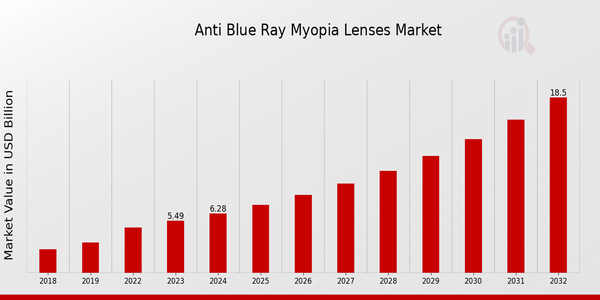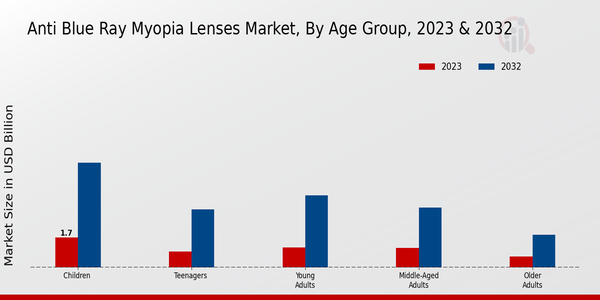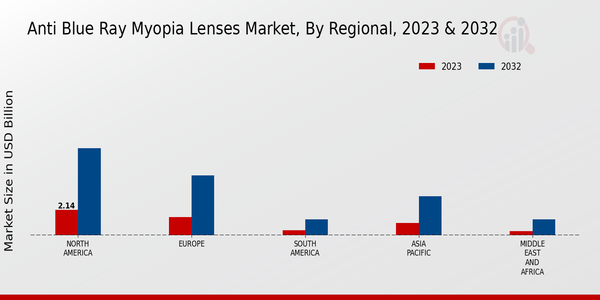Anti Blue Ray Myopia Lenses Market Overview
As per MRFR analysis, the anti blue ray myopia lenses market size was estimated at 2.95 (USD Billion) in 2023. The anti blue ray myopia lenses market industry is expected to grow from 3.2 (USD Billion) in 2024 to 5.66 (USD Billion) by 2032. The anti blue ray myopia lenses market CAGR (growth rate) is expected to be around 6.53% during the forecast period (2024-2032).
Key Anti Blue Ray Myopia Lenses Market Trends Highlighted
The Anti Blue Ray Myopia Lenses Market is driven by the rising prevalence of myopia, or near sightedness, and the increasing awareness of the harmful effects of blue light exposure on eye health. Technological advancements, such as the development of photochromic lenses and lenses with variable focal lengths, are further fueling market growth.
Key opportunities for market players lie in expanding into emerging markets, collaborating with eyewear manufacturers to offer integrated solutions, and investing in research and development to enhance product features. Recent trends include the integration of smart technology into lenses, the adoption of personalized prescription lenses, and the growing preference for aesthetically appealing frames. By leveraging these opportunities and adapting to evolving consumer demands, manufacturers can capitalize on the growing demand for anti blue ray myopia lenses.

Source: Primary Research, Secondary Research, MRFR Database and Analyst Review
Anti Blue Ray Myopia Lenses Market Drivers
Rising Prevalence of Myopia Globally
Myopia, or nearsightedness, is a common vision condition that affects people of all ages. It occurs when the eyeball is too long or the cornea is too curved, causing light to focus in front of the retina instead of on it. This results in blurred vision for distant objects while near objects appear clear. The prevalence of myopia has been increasing steadily over the past few decades, and it is now estimated that about 25% of the world's population is nearsighted.
This increase in myopia is thought to be due to a combination of genetic and environmental factors, including spending more time indoors and engaging in near-work activities such as reading and using digital devices. As the prevalence of myopia continues to rise, there is a growing demand for myopia control measures, including anti-blue ray myopia lenses.
Increasing Awareness of the Harmful Effects of Blue Light
Blue light is a type of high-energy visible light that is emitted from the sun and from artificial sources such as digital devices, fluorescent lights, and LED lights. Exposure to blue light has been linked to several health problems, including digital eye strain, sleep disturbances, and age-related macular degeneration.
While blue light is essential for regulating the body's circadian rhythm and mood, too much exposure to blue light can be harmful. Anti-blue ray myopia lenses are designed to block or filter out blue light, thereby reducing the risk of these harmful effects.
Growing Demand for Eye Care Products and Services
The global eye care market is rapidly growing. There are several reasons for that, namely
- Increasing prevalence of eye diseases
- Rising disposable incomes
- Growing awareness about the Importance of eye health
As such, nowadays, more and more people are interested in eye care products. Today, one of the products that are becoming increasingly popular is anti-blue ray myopia lenses. More and more people start to realize the harmful effects of blue light and the benefits of protecting their eyes.
Anti Blue Ray Myopia Lenses Market Segment Insights
Anti Blue Ray Myopia Lenses Market Age Group Insights
The Anti Blue Ray Myopia Lenses Market segmentation by age group offers crucial insights into the target consumer base. The market is categorized into children (5-12 years), teenagers (13-19 years), young adults (20-39 years), middle-aged adults (40-64 years), and older adults (65 years and above).
Children (5-12 years) represent a significant segment, accounting for a substantial portion of the Anti Blue Ray Myopia Lenses Market revenue. The rising prevalence of myopia and increased screen time among children drive the growth in this segment. Parents are increasingly investing in protective eyewear for their children, recognizing the long-term benefits of mitigating blue light exposure.
Teenagers (13-19 years) are another key segment, as they spend considerable time on digital devices for education, entertainment, and social media. The fashion-conscious nature of this age group creates demand for stylish and trendy anti-blue ray myopia lenses.
Young adults (20-39 years) constitute a large segment, driven by the increasing adoption of digital technologies and prolonged screen use. Concerns about eye strain, dry eyes, and potential long-term effects of blue light exposure contribute to the growth of this segment.
Middle-aged adults (40-64 years) are also a significant segment. As presbyopia becomes more prevalent with age, the demand for multifocal or progressive lenses with blue light protection features is expected to increase.
Older adults (65 years and above) represent a growing segment due to the increasing prevalence of age-related eye conditions, such as cataracts and macular degeneration. Anti-blue ray myopia lenses can help protect their sensitive eyes from harmful blue light, contributing to the growth of this segment.
Understanding the age group segmentation is crucial for anti blue ray myopia lenses market manufacturers and distributors to develop targeted marketing strategies and tailor their products to meet the specific needs and preferences of each age group.

Source: Primary Research, Secondary Research, MRFR Database and Analyst Review
Anti Blue Ray Myopia Lenses Market Application Insights
The application segment of the Anti Blue Ray Myopia Lenses Market is categorized into computer glasses, eyeglasses, and contact lenses. Among these, computer glasses are projected to dominate the market with a substantial revenue share in 2023, owing to the increasing adoption of electronic devices and the rising prevalence of digital eye strain.
Eyeglasses are expected to hold a significant market share due to their widespread usage for vision correction and protection from harmful blue light. Contact lenses offer convenience and are gaining popularity among consumers, leading to a steady growth in their market share. The increasing awareness about the detrimental effects of blue light on eye health is driving the overall growth of the anti blue ray myopia lenses market.
Anti Blue Ray Myopia Lenses Market Frame Material Insights
The Anti Blue Ray Myopia Lenses Market is segmented based on frame material into plastic, metal, acetate, wood, and titanium. Plastic is the most used frame material, accounting for over 60% of the market share in 2023. It is lightweight, durable, and affordable.
Metal frames are also popular, especially among those who prefer a more premium look. Acetate frames are made from a type of cellulose and are known for their durability and hypoallergenic properties. Wood frames are becoming increasingly popular due to their unique and stylish appearance.
Titanium frames are the most expensive option but are also the most durable and lightweight. The market for anti-blue ray myopia lenses is expected to grow significantly in the coming years, driven by increasing awareness of the harmful effects of blue light and the rising prevalence of myopia.
Anti Blue Ray Myopia Lenses Market Lens Material Insights
The lens material segment of the Anti Blue Ray Myopia Lenses Market is anticipated to witness significant growth in the coming years, driven by increasing consumer awareness about the harmful effects of blue light on eye health.
Among the various lens materials available, glass holds a substantial market share due to its scratch resistance and clarity. Polycarbonate, known for its impact resistance and lightweight properties, is widely used in sports and children's eyewear. CR-39 (hard resin) offers a cost-effective option with good optical clarity and durability.
Trivex, a relatively new material, provides excellent impact resistance, clarity, and UV protection. As consumer demand for advanced lens materials grows, manufacturers are focusing on developing innovative products that combine durability, optical performance, and blue light protection.
The Anti Blue Ray Myopia Lenses Market segmentation provides valuable insights into the market dynamics, allowing stakeholders to make informed decisions and capitalize on growth opportunities.
Anti Blue Ray Myopia Lenses Market Regional Insights
The Anti Blue Ray Myopia Lenses Market is segmented into North America, Europe, Asia-Pacific, South America, and the Middle East and Africa. North America is expected to hold the largest share of the market in 2023, followed by Europe and Asia-Pacific.
The Asia-Pacific region is expected to grow at the highest CAGR during the forecast period, owing to the increasing prevalence of myopia in the region. In 2023, the Anti Blue Ray Myopia Lenses Market revenue in North America is expected to be around USD 2.5 billion, while the market in Europe is expected to be around USD 1.8 billion.
The Asia-Pacific region is expected to have a market size of around USD 1.2 billion in 2023. The market in South America and the Middle East and Africa is expected to be around USD 0.5 billion and USD 0.4 billion, respectively, in 2023.
The growth of the anti blue ray myopia lenses market is attributed to the increasing prevalence of myopia, the rising awareness of the harmful effects of blue light on the eyes, and the growing popularity of digital devices. The market is also expected to benefit from the increasing adoption of anti-blue light lenses in eyeglasses and sunglasses.

Source: Primary Research, Secondary Research, MRFR Database and Analyst Review
Anti Blue Ray Myopia Lenses Market Key Players and Competitive Insights
The major players in anti blue ray myopia lenses market are constantly striving to gain a competitive edge over other players. Competitors are spending heavily on research and development to come up with new products that have a better market penetration and acceptance ratio.
The market has a high intensity of competition among the players who consider it imperative to set themselves apart from others. Partnerships, acquisitions, and collaboration are one of the common strategies followed by the leading players to expand their product portfolio and their hold over the market.
EssilorLuxottica is one of the biggest players in the Anti Blue Ray Myopia Lenses Market and has a widespread presence in all the developed and emerging markets. The company has a pretty good spectrum of Anti Blue Ray Lenses. Blue Protect System is one of the popular products from the company. The company has an extensive reach in its distribution network and a significant share of the anti blue ray myopia lenses market.
The company’s heritage and brand name are some of its biggest strengths. Due to its commitment to innovation, the company retains a leading edge in the market and has plans to remain a leading player. The company is committed to ensuring customer satisfaction by offering innovative, efficient, and best-in-case products.
Zeiss is yet another major player in the Anti Blue Ray Myopia Lenses Market with a well-extended range of high-quality lenses. The company has gained significant recognition with eye care professionals. DuraVision BlueProtect is a popular brand in the anti blue ray myopia lens range of products.
The company has a significant presence in Europe and North America and continues to grow in other geographies. The company has a rich tradition of research and development and has come up with many new products. The company has following among its customers due to its precision and quality in products.
Key Companies in the Anti Blue Ray Myopia Lenses Market Include
- Safilo Group
- Shamir
- Kering Eyewear
- Nikon
- Hoya Lens Philippines
- Carl Zeiss
- Essilor
- Vision Ease
- Marchon
- Luxottica Group
- Marcolin
- Seiko Optical
- HOYA
- De Rigo Vision
- Rodenstock
Anti Blue Ray Myopia Lenses Market Developments
The Anti Blue Ray Myopia Lenses Market is expected to witness significant growth over the forecast period, owing to the increasing prevalence of myopia and the growing awareness of the harmful effects of blue light. Some recent developments in the market include:
Launch of new products Key players in the market are launching new products with advanced features and technologies. For instance, in 2023, Essilor launched a new range of anti-blue light lenses called EyeZen Boost, which are designed to protect the eyes from harmful blue light while providing clear vision.
Strategic partnerships and collaborations
Companies are forming strategic partnerships and collaborations to expand their reach and enhance their product offerings. For example, in 2022, Hoya partnered with Samsung to develop and distribute anti-blue light lenses for Samsung's smartphones and tablets.
Growing adoption in emerging markets
The market is witnessing growing adoption in emerging markets, such as China and India, due to the increasing disposable income and the rising awareness of eye care.
Government initiatives
Governments in various countries are implementing initiatives to promote eye health and reduce the prevalence of myopia. For instance, the Chinese government launched a program in 2021 to provide free eye exams and glasses to children in rural areas.
Anti Blue Ray Myopia Lenses Market Segmentation Insights
Anti Blue Ray Myopia Lenses Market Age Group Outlook
- Children (5-12 years)
- Teenagers (13-19 years)
- Young Adults (20-39 years)
- Middle-Aged Adults (40-64 years)
- Older Adults (65 years and above)
Anti Blue Ray Myopia Lenses Market Application Outlook
- Computer Glasses
- Eyeglasses
- Contact Lenses
Anti Blue Ray Myopia Lenses Market Frame Material Outlook
- Plastic
- Metal
- Acetate
- Wood
- Titanium
Anti Blue Ray Myopia Lenses Market Lens Material Outlook
- Glass
- Polycarbonate
- CR-39 (Hard Resin)
- Trivex
Anti Blue Ray Myopia Lenses Market Regional Outlook
- North America
- Europe
- South America
- Asia Pacific
- Middle East and Africa
| Report Attribute/Metric |
Details |
| Market Size 2023 |
2.95(USD Billion) |
| Market Size 2024 |
3.2(USD Billion) |
| Market Size 2032 |
5.66(USD Billion) |
| Compound Annual Growth Rate (CAGR) |
6.53% (2024 - 2032) |
| Report Coverage |
Revenue Forecast, Competitive Landscape, Growth Factors, and Trends |
| Base Year |
2023 |
| Market Forecast Period |
2024 - 2032 |
| Historical Data |
2019 - 2023 |
| Market Forecast Units |
USD Billion |
| Key Companies Profiled |
Safilo Group, Shamir, Kering Eyewear, Nikon, Hoya Lens Philippines, Carl Zeiss, Essilor, Vision Ease, Marchon, Luxottica Group, Marcolin, Seiko Optical, HOYA, De Rigo Vision, Rodenstock |
| Segments Covered |
Age Group, Application, Frame Material, Lens Material, Region |
| Key Market Opportunities |
Competitive Pricing Growing Health Concerns Technological Advancements Ecommerce Expansion Increasing Prevalence of Eye Strain |
| Key Market Dynamics |
Rising prevalence of myopia Increasing demand for digital devices Technological advancements Growing awareness of eye health Ecommerce penetration |
| Countries Covered |
North America, Europe, APAC, South America, MEA |
Frequently Asked Questions (FAQ) :
The Anti Blue Ray Myopia Lenses Market is expected to reach USD 5.66 Billion by 2032, growing at a CAGR of 6.53% from 2023 to 2032.
The key regions in the Anti Blue Ray Myopia Lenses Market are North America, Europe, Asia Pacific, Latin America, and the Middle East and Africa.
The key applications of anti blue ray myopia lenses include reducing eye strain, improving sleep quality, and protecting eyes from harmful blue light.
Key competitors in the Anti Blue Ray Myopia Lenses Market include EssilorLuxottica, Hoya, Rodenstock, Nikon, and Carl Zeiss.
The growth drivers of the Anti Blue Ray Myopia Lenses Market include increasing awareness of the harmful effects of blue light, rising demand for eye protection, and growing adoption of digital devices.
The challenges faced by the Anti Blue Ray Myopia Lenses Market include high cost of production, limited availability of skilled labor, and intense competition.
The opportunities for the Anti Blue Ray Myopia Lenses Market include technological advancements, growing demand from emerging markets, and increasing adoption of online sales channels.
The key trends in the Anti Blue Ray Myopia Lenses Market include increasing demand for personalized lenses, rising popularity of photochromic lenses, and growing adoption of augmented reality and virtual reality devices.
The Anti Blue Ray Myopia Lenses Market is expected to grow at a CAGR of 6.53% from 2023 to 2032.
The base year for the Anti Blue Ray Myopia Lenses Market forecast is 2023.

















